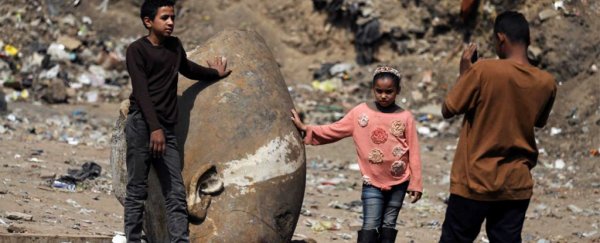From a city at the centre of all creation to working class district, the ground beneath Matariya in Cairo has seen a lot in the past few millennia.
Last week archaeologists pulled from the water-logged construction site an 8 metre (26 foot) statue thought to be of Ramses II – one of the most powerful rulers in the ancient world.
"Last Tuesday they called me to announce the big discovery of a colossus of a king, most probably Ramses II, made out of quartzite," Antiquities Minister Khaled al-Anani told Reuters.
Modern day El Matariya is a district to the east of Cairo's centre, described by some as 'poor but far from miserable', with backstreets of mud roads and half-finished construction.
Three thousand years ago the area containing the area went by a different name – Heliopolis; a massive sacred temple believed by ancient priests to mark the place where the sun-god and the Universe first emerged.
The district isn't blind to its regal history; an ancient 21 metre (69 foot) obelisk still stands in its original position in the centre one of its squares.
Yet thousands of years of history have seen many of the temple's treasures and stones taken for convenient building materials or to display in foreign museums and private collections, making new finds increasingly rare.
So the discovery of a colossal quartzite bust and head by Egypt's Ministry of Antiquities and researchers from the University of Leipzig is attracting attention from around the world.
"We found the bust of the statue and the lower part of the head and now we removed the head and we found the crown and the right ear and a fragment of the right eye," said al-Anani.
While the statue didn't come with a name-tag, and kings weren't permitted to live within the temple, the researchers are confident it represents Ramses II – also known as Ramses the Great as well as Ozymandias – who ruled Egypt for nearly 70 years from 1279 to 1213 BCE.
The pharaoh earned his reputation after securing Egypt's borders through wars conducted against the Hittites, who occupied what is largely Turkey and the upper Middle East today, as well as taking back territory taken by the Syrians, Libyans, and the Nubians in northern Sudan.
A smaller statue identified as the king's grandson, Seti II, was also discovered nearby.
References to the king have been unearthed in the district before, with a variant on his name etched into a temple stone discovered only last year, while evidence of the famous ruler has also been found in other Heliopolis sites around Cairo.
Further excavations will be conducted on the site and statue will be studied by archaeologists before being erected in the new Great Egyptian Museum, which is expected to open in 2018.
The find could help boost the country's flagging tourism industry, which has yet to recover to previous heights after the revolution which saw the ousting of its president Hosni Mubarak in 2011.
For the residents of Matariya, however, the uncovered giant has provided a momentary opportunity to connect with a sacred past hidden by time.
